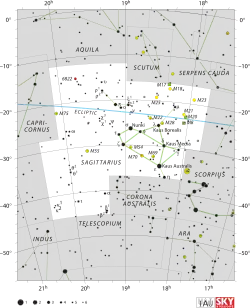 | |
| Observation data Epoch J2000.0 Equinox J2000.0 (ICRS) | |
|---|---|
| Constellation | Sagittarius |
| Right ascension | 19h 59m 44.17834s[1] |
| Declination | −35° 16′ 34.7049″[1] |
| Apparent magnitude (V) | 4.37[2] |
| Characteristics | |
| Spectral type | B3 IVp[3] |
| U−B color index | −0.67[2] |
| B−V color index | −0.15[2] |
| Astrometry | |
| Proper motion (μ) | RA: +5.60[1] mas/yr Dec.: −25.81[1] mas/yr |
| Parallax (π) | 6.29 ± 0.21 mas[1] |
| Distance | 520 ± 20 ly (159 ± 5 pc) |
| Absolute magnitude (MV) | −1.63[4] |
| Orbit[5] | |
| Period (P) | 2.1051 d |
| Eccentricity (e) | 0.00 |
| Periastron epoch (T) | 2411140.645 JD |
| Argument of periastron (ω) (secondary) | 0.00° |
| Semi-amplitude (K1) (primary) | 15.9 km/s |
| Details | |
| θ1 Sgr A | |
| Mass | 6.6±0.1[6] M☉ |
| Radius | 5.6[7] R☉ |
| Luminosity (bolometric) | 2,271[8] L☉ |
| Temperature | 17,900[8] K |
| Rotational velocity (v sin i) | 73[3] km/s |
| Age | 32.8±5.0[6] Myr |
| Other designations | |
| Database references | |
| SIMBAD | data |
Theta1 Sagittarii (θ1 Sagittarii) is a close binary star[10] system in the zodiac constellation of Sagittarius. It is visible to the naked eye with an apparent visual magnitude of 4.37.[2] Based upon an annual parallax shift of 6.29 mas as seen from Earth,[1] this star is located around 520 light years from the Sun. At that distance, the visual magnitude is diminished by an extinction factor of 0.24 due to interstellar dust.[11]
This is a single-lined spectroscopic binary with an orbital period of just 2.1 days in a circular orbit.[5] The visible member, component A, is a B-type subgiant star with a stellar classification of B3 IVp.[3] It is around 33[6] million years old and is spinning with a projected rotational velocity of 73 km/s.[3] The primary has 6.6[6] times the mass of the Sun and about 5.6[7] times the Sun's radius. It is radiating 2,271[8] times the solar luminosity from its photosphere at an effective temperature of 17,900 K.[8]
References
- 1 2 3 4 5 6 van Leeuwen, F. (2007), "Validation of the new Hipparcos reduction", Astronomy and Astrophysics, 474 (2): 653–664, arXiv:0708.1752, Bibcode:2007A&A...474..653V, doi:10.1051/0004-6361:20078357, S2CID 18759600.
- 1 2 3 4 Nicolet, B. (1978), "Photoelectric photometric Catalogue of homogeneous measurements in the UBV System", Astronomy and Astrophysics Supplement Series, 34: 1–49, Bibcode:1978A&AS...34....1N.
- 1 2 3 4 Levato, H. (1975), "Rotational velocities and spectral types for a sample of binary systems", Astronomy and Astrophysics, 19: 91, Bibcode:1975A&AS...19...91L
- ↑ Anderson, E.; Francis, Ch. (2012), "XHIP: An extended hipparcos compilation", Astronomy Letters, 38 (5): 331, arXiv:1108.4971, Bibcode:2012AstL...38..331A, doi:10.1134/S1063773712050015, S2CID 119257644.
- 1 2 Pourbaix, D.; et al. (2004), "SB9: The ninth catalogue of spectroscopic binary orbits", Astronomy and Astrophysics, 424 (2): 727–732, arXiv:astro-ph/0406573, Bibcode:2004A&A...424..727P, doi:10.1051/0004-6361:20041213, S2CID 119387088.
- 1 2 3 4 Tetzlaff, N.; et al. (January 2011), "A catalogue of young runaway Hipparcos stars within 3 kpc from the Sun", Monthly Notices of the Royal Astronomical Society, 410 (1): 190–200, arXiv:1007.4883, Bibcode:2011MNRAS.410..190T, doi:10.1111/j.1365-2966.2010.17434.x, S2CID 118629873.
- 1 2 Pasinetti Fracassini, L. E.; et al. (February 2001), "Catalogue of Apparent Diameters and Absolute Radii of Stars (CADARS)", Astronomy and Astrophysics (Third ed.), 367: 521–524, arXiv:astro-ph/0012289, Bibcode:2001A&A...367..521P, doi:10.1051/0004-6361:20000451, S2CID 425754.
- 1 2 3 4 Hohle, M. M.; et al. (2010), "Masses and luminosities of O- and B-type stars and red supergiants", Astronomische Nachrichten, 331 (4): 349, arXiv:1003.2335, Bibcode:2010AN....331..349H, doi:10.1002/asna.200911355, S2CID 111387483.
- ↑ "tet01 Sgr". SIMBAD. Centre de données astronomiques de Strasbourg. Retrieved 2017-07-07.
{{cite web}}: CS1 maint: postscript (link) - ↑ Eggleton, P. P.; Tokovinin, A. A. (September 2008), "A catalogue of multiplicity among bright stellar systems", Monthly Notices of the Royal Astronomical Society, 389 (2): 869–879, arXiv:0806.2878, Bibcode:2008MNRAS.389..869E, doi:10.1111/j.1365-2966.2008.13596.x, S2CID 14878976.
- ↑ Gontcharov, G. A. (November 2012), "Spatial distribution and kinematics of OB stars", Astronomy Letters, 38 (11): 694–706, arXiv:1606.09028, Bibcode:2012AstL...38..694G, doi:10.1134/S1063773712110035, S2CID 119108982.